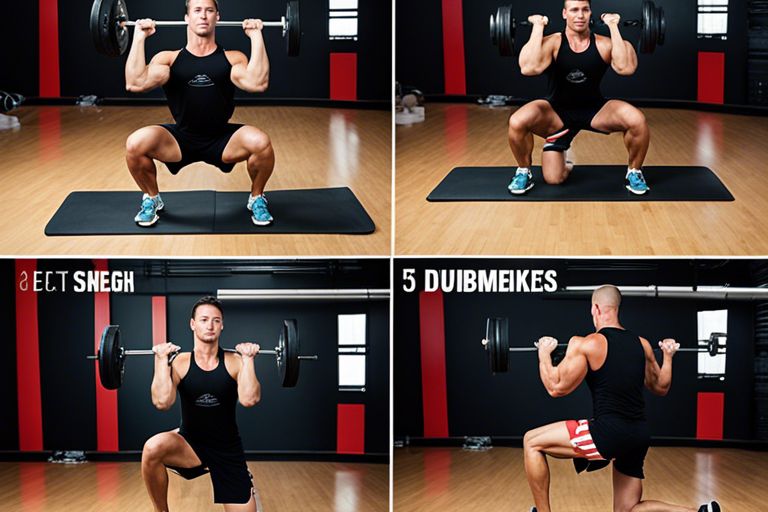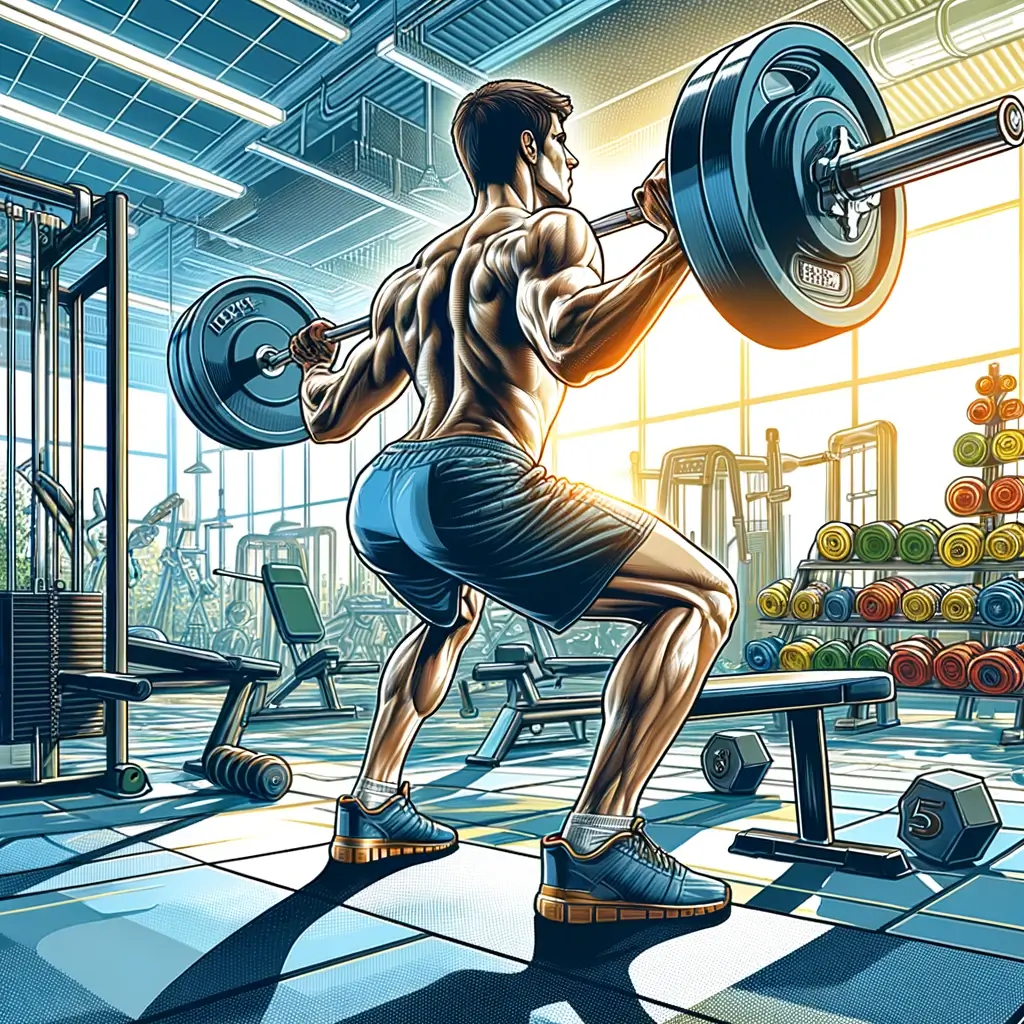Training like a pro means mastering the fundamental strength training exercises that form the backbone of any successful fitness routine. Whether you’re a beginner looking to build a solid foundation or an experienced lifter aiming to level up, these vital exercises will help you achieve your goals effectively and safely. From squats and deadlifts to bench presses and overhead presses, mastering these movements will not only improve your overall strength but also enhance your muscle definition, stability, and athletic performance. Avoiding common mistakes and maintaining proper form are crucial to preventing injuries and maximizing your gains. In this guide, we’ll break down these key exercises and provide tips on how to perform them correctly to lift like a pro and attain your fitness goals.
Key Takeaways:
- Proper Form is Crucial: Ensure you have the correct form when performing strength training exercises to prevent injuries and maximize the effectiveness of each movement.
- Progressive Overload is Key: Continuously challenge your muscles by gradually increasing the weight or intensity of your workouts to promote muscle growth and strength gains.
- Include Compound Movements: Incorporate compound exercises like squats, deadlifts, and bench presses into your routine as they target multiple muscle groups, allowing for efficient and effective strength gains.
Foundations of Successful Strength Training
It is necessary to establish a solid foundation when initiateing on a strength training journey. Building a strong base will not only help you achieve your fitness goals but also prevent injuries and setbacks along the way. In this chapter, we will examine into the key principles and philosophies that form the cornerstone of successful strength training.
Key Principles for Growth and Safety
Principles of growth and safety in strength training are crucial for long-term success. Consistency is key – regularity in your workouts allows your muscles to adapt and grow stronger over time. Gradually increasing the intensity and challenge of your exercises is also important to prevent plateauing and ensure continued progress. Additionally, proper form and technique must always be prioritized to avoid injury and maximize the effectiveness of each movement.
Crafting Your Personal Fitness Philosophy
The process of crafting your personal fitness philosophy involves defining your values, goals, and motivations. Understanding why you are pursuing strength training will help you stay committed and focused on your journey. By developing a clear philosophy that aligns with your beliefs and aspirations, you can create a roadmap for success in your fitness endeavors.
For instance, reflecting on the reasons behind your desire to get stronger and fitter can give you a sense of purpose and drive. Whether your goal is to improve your physical health, boost your confidence, or challenge yourself, having a well-defined fitness philosophy will guide your actions and decisions along the way.
Core Strength Training Exercises
Even though strength training is vital for overall physical fitness, core strength training exercises are particularly important for enhancing stability, improving posture, and preventing injuries. A strong core serves as the powerhouse for all other movements, making it a crucial component of any workout routine.
Squats: The Quintvital Power Move
Quintvital of strength training, squats are one of the best exercises for building lower body strength and muscle mass. By engaging multiple muscle groups, including the quadriceps, hamstrings, and glutes, squats not only enhance your lower body strength but also improve your overall balance and coordination.
For a proper squat technique, stand with your feet shoulder-width apart, keeping your chest up and your back straight. Slowly lower your body as if you are sitting back into a chair, ensuring your knees do not go beyond your toes. Push through your heels to return to the starting position, squeezing your glutes at the top for maximum benefit.
Deadlifts: The Ultimate Test of Raw Strength
Squats may be the king of lower body exercises, but deadlifts reign supreme as the ultimate test of raw strength. This compound exercise targets the posterior chain, including the lower back, glutes, and hamstrings, making it a go-to exercise for building overall strength and muscle mass.
Plus, the deadlift is a functional movement that mimics everyday activities like lifting heavy objects off the ground, making it incredibly practical for real-life scenarios. However, proper form is crucial when performing deadlifts to avoid injury and maximize results. Engage your core, keep your back straight, and lift with your legs to ensure a safe and effective deadlift.
Recall, core strength is the foundation of all movements, so be sure to incorporate these core strength training exercises into your workout routine to enhance your physical performance and achieve your fitness goals.
Upper Body Strength Essentials
Now that we’ve covered the basics of strength training, it’s time to examine into the imperative exercises that every pro incorporates into their routine for building a strong and powerful upper body. These exercises are the foundation of any successful strength training program and will help you reach your fitness goals efficiently and effectively.
Bench Press: Building Chest and Arms
Bench press is a classic strength training exercise that targets the chest, shoulders, and arms. It is a compound movement that engages multiple muscle groups at once, making it incredibly efficient for building overall upper body strength. By mastering the bench press and progressively increasing the weight you lift, you can develop a powerful chest and arms that not only look impressive but also provide the strength needed for other exercises.
Pull-ups and Rows: Sculpting the Back and Shoulders
Essentials – Pull-ups and rows are imperative exercises for sculpting the back and shoulders. Pull-ups target the upper back, shoulders, and arms, while rows engage the mid-back muscles. These exercises help improve posture, strengthen the upper body muscles, and enhance overall upper body definition. Incorporating pull-ups and rows into your routine will not only help you achieve a well-rounded upper body but also improve your performance in other exercises.
Rows – When performing rows, it’s important to maintain proper form to avoid strain on the back. Keep your back straight, engage your core, and focus on squeezing your shoulder blades together with each repetition. Progressively increase the weight you lift to continually challenge your muscles and promote growth. Including rows in your routine will help you build a strong and sculpted back that complements your chest and shoulders, creating a balanced and powerful upper body.
Optimizing Your Routine
Once again, we research into maximizing your strength training routine. To truly lift like a pro, it is crucial to optimize every aspect of your workout regimen. From periodization to recovery and nutrition, every detail counts in the pursuit of peak performance.
Periodization: Timing Your Progress
Timing is crucial in the world of strength training, especially when it comes to periodization. Periodization involves dividing your training into specific phases to target different aspects of strength and conditioning. By strategically varying the intensity and volume of your workouts over time, you can prevent plateauing and continue to make steady gains. Whether you’re focusing on hypertrophy, strength, or power, a well-structured periodized program can take your training to the next level.
Recovery and Nutrition: The Silent Partners in Strength
Timing your recovery and nutrition is just as important as timing your workouts. Proper rest and nutrition are the silent partners in your strength training journey, playing a critical role in muscle repair and growth. Adequate protein intake, hydration, quality sleep, and active recovery strategies all contribute to optimal performance and recovery. Ignoring these crucial elements can lead to fatigue, injury, and hindered progress in the long run.
Progress in strength training is not just about the hours spent in the gym, but also the hours spent resting and refueling your body. By prioritizing recovery and nutrition alongside your training, you can ensure that your body is primed for growth and adaptation. Note, true strength and gains are forged not just in the iron temple, but also in the choices you make outside of it.

To wrap up
Hence, mastering crucial strength training exercises not only improves your physical health but also your mental acuity. Just as science unlocks the mysteries of the universe, understanding the mechanics of strength training can unlock the potential of your body. By incorporating these exercises into your routine and approaching them with a scientific mindset, you can lift like a pro and reach new heights of strength and fitness prowess.
FAQ
Q: What is the importance of strength training exercises?
A: Strength training exercises are important for building and maintaining muscle mass, increasing metabolism, improving bone density, and enhancing overall strength and endurance.
Q: How often should I perform strength training exercises?
A: It is recommended to engage in strength training exercises at least 2-3 times per week to allow for proper muscle recovery and growth.
Q: What are some examples of important strength training exercises?
A: Some important strength training exercises include squats, deadlifts, bench press, shoulder press, and rows, as they target major muscle groups and promote functional strength.
Q: How should I progress in my strength training routine?
A: To progress in your strength training routine, gradually increase the weight you lift, vary your exercises, incorporate new techniques, and ensure proper form to prevent injuries.
Q: Is it important to warm up before strength training exercises?
A: Yes, warming up before strength training exercises is crucial to prepare your muscles, joints, and cardiovascular system for the workout, reducing the risk of injuries and improving performance.

